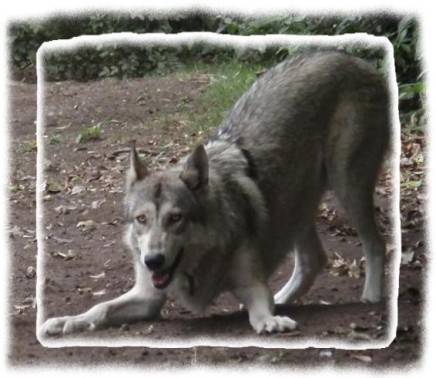|
Characteristics of Genetic Disease
The character of a genetic disease includes its severity and age of
onset. Diseases that cause death or significant discomfort or those that
are not treatable should have a high priority in genetic disease
control. Disorders with a late-age onset are more difficult to control
because genetically affected dogs can be bred before becoming clinically
affected.
Bell, who is frequently asked to give talks about genetics to breed
clubs, says unlike many other veterinary specialties, there is no
board-certification subspecialty in genetics. "A limited number of
individuals have genetic counselling expertise," he says. "The idea is to
counsel breeders and dog owners to decrease carrier frequency, without
affecting genetic diversity."
George Padgett, D.V.M., professor of pathology at Michigan State
University in East Lansing and an authority on canine genetic disease,
says, "A veterinarian’s advice to a breeder who couldn’t determine the
cause of an undesirable trait was, ‘Don’t worry about it, outcross, and
even if it is genetic, it will go away.’"
"This advice has messed up breeds of dogs from the beginning of time,"
Padgett says. "Instead of controlling a trait when there are one or two
dogs, or one or two families involved, we outcross the dogs and spread
the trait throughout the breed."
Greg Acland, B.V. Sc., of The James A. Baker Institute for Animal Health
at Cornell University in Ithaca, N.Y., a contributor to discovery of the
genes causing progressive retinal atrophy and congenital stationary
night blindness, says, "For a lot of disorders, until a test is
developed, the best method of breeding is a scientific evaluation to
prevent carrier-to-carrier matings and eliminate affected individuals."
"Breeding decisions are not black and white," Bell says. "The best plan
is to stay informed about genetic disease and be a concerned breeder for
the health and welfare of the breed -- for your dogs and for the dogs
you pass on to other owners."
Modes of Inheritance
A dog is the product of its genotype, or genes, acting in a specific
environment. Its phenotype is an expression of both the genotype and the
environment. Four modes of inheritance cause most genetic defects in
dogs: autosomal recessive or simple recessive; autosomal dominant;
sex-linked recessive; and polygenic.
An autosomal or simple recessive trait results when a matched pair of
genes is present on any of 38 pairs of autosomes. An autosome is a
nonsex chromosome. Both parents of an affected puppy are carriers of the
abnormal gene, but generally do not show the trait.
An autosomal dominant trait results when a trait is expressed even
though the pair of genes causing the trait are not matched. Dominant
traits are expressed in the heterozygous state, which means only one
parent must have a defective gene for the disorder to cause the trait to
occur among the offspring.
"Canine hip dysplasia is an example of a polygenic disorder. Most
breeders have attempted to control hip dysplasia by selecting for
pedigree depth of normal hips. With polygenic disorders, however, the
breadth of the pedigree is as important an indicator as the depth of the
pedigree. The phenotype of the full siblings provides a better
reflection of the genes carried by the breeding individual than the
phenotype of the parents. It is expected that the phenotypically normal
dog with only one dysplastic littermate would carry fewer genes for
dysplasia than the phenotypically normal dog whose littermates all had
hip dysplasia. If a preponderance of the siblings of the parent and
grandparents are phenotypically normal, there is a greater chance of
producing normal offspring." Jerold Bell, D.V.M.
Sex-linked genes can be either dominant or recessive and always appear
on the X-chromosome, making females carriers. The same distinctions
between autosomal dominant and recessive traits also apply to sex-linked
traits. For example, the dominant gene hides the recessive gene in the
female since the female has two X chromosomes. In the male, with only
one X chromosome, the single recessive gene that is part of that
chromosome expresses itself, causing the same trait that seems to
require two genes in the female.
Polygenic traits are controlled by a number of genes, each of which adds
in increments to the total phenotype. These are called complex traits
because multiple genes are involved. Polygenic traits also are called
complex traits because environmental factors are involved.
Genetic Testing
When trying to lower the frequency of a particular mutation, Bell says,
the key is to remember there are many good genes to keep, so you don’t
want to immediately eradicate all carriers from the gene pool. Genetic
tests present an opportunity to focus on producing quality, genetically
normal dogs by replacing carriers with normal testing offspring.
There are two types of genetic tests: linkage tests and gene-specific
tests or DNA diagnostic tests. Linkage tests, in which a linked marker
signifies a genetic marker and a disease gene that are close together on
one chromosome, are expected to become more common as the canine genome
map evolves. "If linkage tests are not appropriately interpreted, the
potential exists for incorrectly assessing the relative risk of carrier
status," Bell says.
Problems with linkage-based tests sometimes happen during crossover of
the dog’s and bitch’s chromosomes during reproduction. This trading of
chromosomal DNA is why entire chromosomes are not passed from one
generation to another and why there is genetic diversity. If a crossover
occurs between the genetic marker and defective gene, recombination
occurs, meaning the marker might suggest there is a defective gene
although the defective gene may no longer be present.
Another error occurs when a linkage test for a genetic marker recognizes
a false allele that is not linked to the disease gene. Two genes at the
same position on matched chromosomes are called alleles. In this
instance, some dogs that look affected on the test may be carriers,
while others may be homozygous normal. There is no way to differentiate
the true linked marker from the false allele.
Though there are fewer gene-specific or DNA diagnostic tests, they are
100 percent accurate, matching the defective gene to the exact mutation
site on the chromosome. DNA tests can be taken from blood, saliva or
hair samples.
"Once there is a reliable genetic test for carriers, the procedure is to
test your own dogs, request test results on the dogs you are looking to
breed, and to use that information in your breeding program," Bell says.
"With good tests and good breeding practices, we can greatly reduce
genetic diseases."
Tips for Breed Clubs On Ways to
Control Genetic Disease
Here are some tips for breed clubs on ways to educate members about
genetic disease and improve their breed. These suggestions are excerpted
from the book Control of Canine Genetic Disease by George A.
Padgett, D.V.M., professor of pathology at Michigan State University.
Generate a list of genetic defects in the breed by surveying members and
owners, and make the list available to members and breeders. Include the
mode of inheritance of each trait if it is known.
Form committees to assess the impact of each breed trait.
Advocate registration of dogs and bitches affected with genetic defects
and those known to carry genes for these traits in an open registry.
Advocate registration of dogs and bitches known to be free of genes for
undesirable traits.
Develop a list of dogs known to be affected or that carry genes for a
given trait that are available for test matings. The list should be made
freely available to breeders and members.
Determine which defects should be attacked on a breed-wide basis.
Develop a brochure describing the diseases that occur in the breed,
giving clinical signs, methods of diagnosis and prognosis. This brochure
should be readily available to club members, breeders and owners of
breed dogs.
Develop a brochure discussing various systems that can be used to
control disease and how to handle carriers and potential carriers of
various traits.
|






![]() Sansorrella 2019 All rights reserved
Sansorrella 2019 All rights reserved